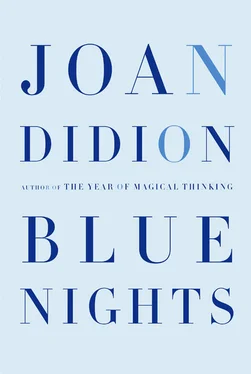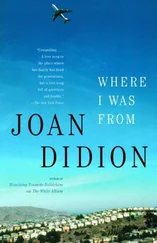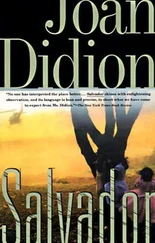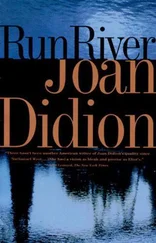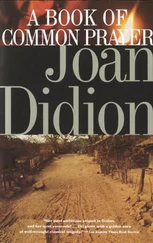1 ...6 7 8 10 11 12 ...25 Terra incognita, as I had seen it until then, meant free of complications.
That terra incognita could present its own complications had never occurred to me.
On the day her adoption became legal, a hot September afternoon in 1966, we took her from the courthouse in downtown Los Angeles to lunch at The Bistro in Beverly Hills. At the courthouse she had been the only baby up for adoption; the other prospective adoptees that day were all adults, petitioning to adopt one another for one or another tax advantage. At The Bistro, too, more predictably, she was the only baby. Qué hermosa , the waiters crooned. Qué chula . They gave us the corner banquette usually saved for Sidney Korshak, a gesture the import of which would be clear only to someone who had lived in that particular community at that particular time. “Let’s just say a nod from Korshak, and the Teamsters change management,” the producer Robert Evans would later write by way of explaining who Sidney Korshak was. “A nod from Korshak, and Vegas shuts down. A nod from Korshak, and the Dodgers suddenly can play night baseball.” The waiters placed her carrier on the table between us. She was wearing a blue-and-white dotted organdy dress. She was not quite seven months old. As far as I was concerned this lunch at Sidney Korshak’s banquette at The Bistro was the happy ending to the choice narrative. We had chosen, the beautiful baby girl had accepted our choice, no natural parent had stood up at the courthouse and exercised his or her absolute legal right under the California law covering private adoptions to simply say no, she’s mine, I want her back.
The issue, as I preferred to see it, was now closed.
The fear was now gone.
She was ours.
What I would not realize for another few years was that I had never been the only person in the house to feel the fear.
What if you hadn’t answered the phone when Dr. Watson called , she would suddenly say. What if you hadn’t been home, what if you couldn’t meet him at the hospital, what if there’d been an accident on the freeway, what would happen to me then?
Since I had no adequate answer to these questions, I refused to consider them.
She considered them.
She lived with them. And then she didn’t.
“You have your wonderful memories,” people said later, as if memories were solace. Memories are not. Memories are by definition of times past, things gone. Memories are the Westlake uniforms in the closet, the faded and cracked photographs, the invitations to the weddings of the people who are no longer married, the mass cards from the funerals of the people whose faces you no longer remember. Memories are what you no longer want to remember.
S idney Korshak, 88, Dies; Fabled Fixer for the Chicago Mob:
So read the headline on Sidney Korshak’s obituary, when he died in 1996, in The New York Times . “It was a tribute to Sidney Korshak’s success that he was never indicted, despite repeated Federal and state investigations,” the obituary continued. “And the widespread belief that he had in fact committed the very crimes the authorities could never prove made him an indispensable ally of leading Hollywood producers, corporate executives and politicians.”
Thirty years before Morty Hall had declared on principle that he and Diana would refuse to go to any party given by Sidney Korshak.
I remember Morty and Diana arguing heatedly at dinner one night over this entirely hypothetical point.
Morty and Diana and the heated argument at dinner about whether or not to refuse to go to a party given by Sidney Korshak are, I have to conclude, what people mean when they mention my wonderful memories.
I recently saw Diana in an old commercial, one of those curiosities that turn up on YouTube. She is wearing a pale mink stole, draping herself over the hood of an Olds 88. In her smoky voice, she introduces the Olds 88 as “the hottest number I know.” The Olds 88 at this point begins to talk to Diana, mentioning its own “rocket engine” and “hydra-matic drive.” Diana wraps herself in the pale mink stole. “This is great ,” she replies to the Olds 88, again in the smoky voice.
It occurs to me that Diana does not sound in this Olds 88 commercial as if she would necessarily refuse to go to a party given by Sidney Korshak.
It also occurs to me that no one who now comes across this Olds 88 commercial on YouTube would know who Sidney Korshak was, or for that matter who Diana was, or even what an Olds 88 was.
Time passes.
Diana is dead now. She died in 1971, at age forty-five, of a cerebral bleed.
She had collapsed after a wardrobe fitting for a picture she was due to start in a few days, the third lead, after Tuesday Weld and Anthony Perkins, in Play It As It Lays , for which John and I had written the screenplay and in which she was replaced by Tammy Grimes. The last time I saw her was in an ICU at Cedars-Sinai in Los Angeles. Lenny and I had gone together to Cedars to see her. The next time Lenny and I were in an ICU at Cedars together it was to see her and Nick’s daughter Dominique, who had been strangled outside her house in Hollywood. “She looks even worse than Diana did,” Lenny whispered when she saw Dominique, her intake of breath so sudden that I could barely hear her. I knew what Lenny was saying. Lenny was saying that Diana had not lived. Lenny was saying that Dominique was not going to live. I knew this — I suppose I had known it from the time the police officer who called identified himself as “Homicide”—but did not want to hear anyone say it. I ran into one of Diana’s daughters a few months ago, in New York. We had lunch in the neighborhood. Diana’s daughter remembered that we had last seen each other when Diana was still alive and living in New York and I had brought Quintana to play with her daughters. We promised to keep in touch. It occurred to me as I walked home that I had seen too many people for the last time in one or another ICU.
F or everything there is a season .
Ecclesiastes, yes, but I think first of The Byrds, “Turn Turn Turn.”
I think first of Quintana Roo sitting on the bare hardwood floors of the house on Franklin Avenue and the waxed terra-cotta tiles of the house in Malibu listening to The Byrds on eight-track.
The Byrds and The Mamas and the Papas, “Do You Wanna Dance?”
“I wanna dance,” she would croon back to the eight-track.
For everything there is a season. I’d miss having the seasons , people from New York like to say by way of indicating the extraordinary pride they take in not living in Southern California. In fact Southern California does have seasons (it has for example “fire season” or “the season when the fire comes,” and it also has “the season when the rain comes,” but such Southern California seasons, arriving as they do so theatrically as to seem strokes of random fate, do not inexorably suggest the passage of time. Those other seasons, the ones so prized on the East Coast, do. Seasons in Southern California suggest violence, but not necessarily death. Seasons in New York — the relentless dropping of the leaves, the steady darkening of the days, the blue nights themselves — suggest only death. For my having a child there was a season. That season passed. I have not yet located the season in which I do not hear her crooning back to the eight-track.
I still hear her crooning back to the eight-track.
I wanna dance .
The same way I still see the stephanotis in her braid, the plumeria tattoo through her veil.
Something else I still see from that wedding day at St. John the Divine: the bright red soles on her shoes.
Читать дальше
Конец ознакомительного отрывка
Купить книгу
